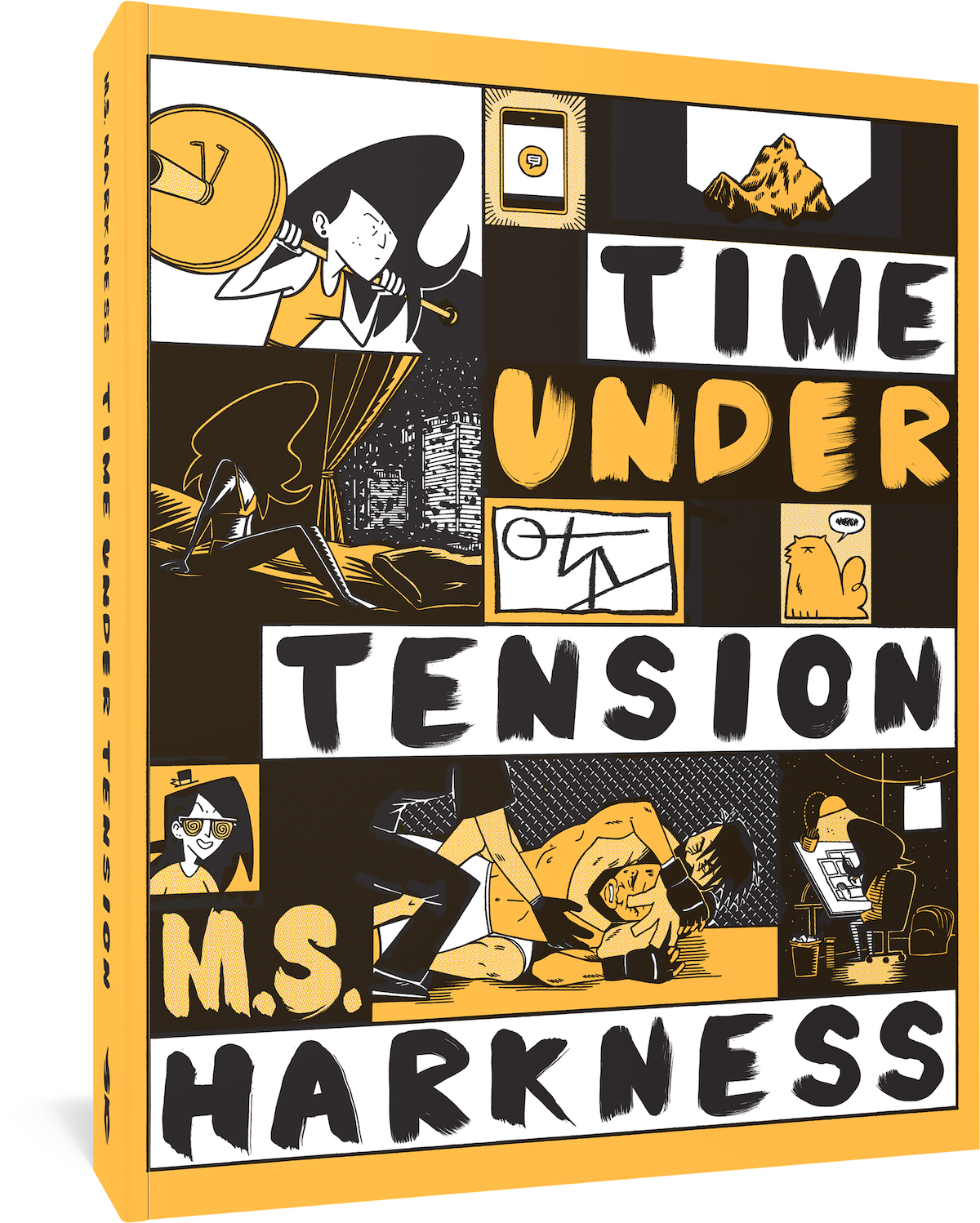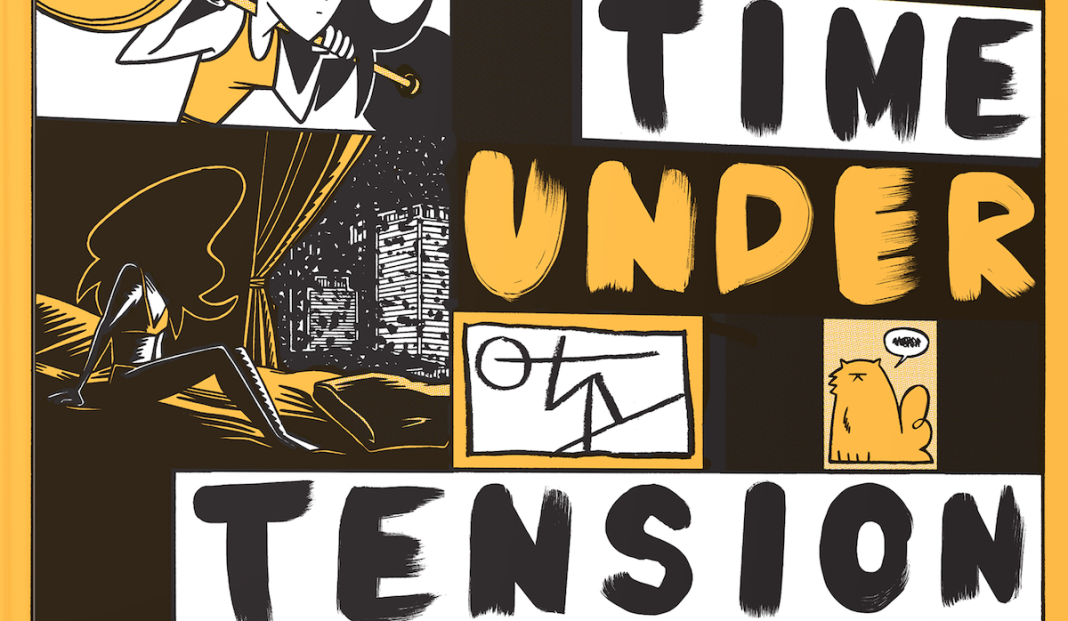
We asked Harkness all about her creative routine, the significance of the book’s title, and about touring across the country in support of Time Under Tension‘s publication.
This interview has been edited for clarity and length.
AVERY KAPLAN: Can you tell us about the genesis of this graphic novel?
M.S. HARKNESS: I am putting this out with the hope and understanding that it’s picking up where the previous book, Desperate Pleasures, left off. It’s the third book in the series that I’m doing just being in my 20s. The last book was pretty emo and pretty dark and kind of just navigating a pretty consistent throughline of like trauma memoir that is “in” right now, I would say… or, you know, wearing everyone out to the point of maybe a little bit being exhausted with it.
So the integration of having a booboo childhood and saying, “Okay, and now what next,” is what this book is about. It’s not anything linear, constantly dealing with the frustrations of life, but still having to live life.
KAPLAN: While it will be immediately obvious to some readers, can you explain the title Time Under Tension and how it relates to this book?
HARKNESS: It’s not super obvious to people who are comic book people. My publisher even took a couple of months to ask, “Wait, this is a weightlifting term?” And I said, “Yeah, it’s the implication here.” It refers to like a kind of training tempo, that when you get more intermediate into lifting weights, it can be described in certain kinds of programs, which is the up-and-down of a repetition.
So if you’re doing a bicep curl, it’s the coming down. The eccentric part of the lift. And how many seconds it takes you to actually do that curl coming up. So it can be really quick, or really slow and drawn out.
I wanted to build that tension across the book: the up-and-down, and the things that are the very obvious tedium of life but then are also the things that feel heaped upon me specifically. And just trying to get a foothold in anything.
KAPLAN: Did any particular narrative challenges emerge while working on Time Under Tension? Conversely, did any elements of the book come together relatively easily?
HARKNESS: This is the first book that I was really trying to focus on telling a very straight narrative. The beginning jumps around quite a bit, mimicking the structure of the previous book, which had a bounce-around, almost word association, way of trying to build some kind of pattern. It’s like when you have a little trauma brain where things are not necessarily actually adding up in a way that makes sense. But you’re trying to fill in the blanks where your memory isn’t quite there.
And so after the first 60 pages, where I’m introducing this character and the other characters that surround them, it’s like, “Okay, now no more fucking around. Here’s a year of life.” A year that was very formative, where it was, “you have to you have to get your shit in a row.” Postgrad. That’s satisfying. And so it was from January or spring through December.
KAPLAN: Can you tell us about the format? I notice it is similar to Desperate Pleasures. Does this reflect the original art?
HARKNESS: When I was with my previous publisher, Uncivilized Books, we were trying to figure out exactly how to format the covers and make them feel different from a lot of memoirs. There’s the main character right on the front, maybe looking away, or it’s a back view or something. And it’s “My Sad Story by Author.” And it’s a little overwrought.
I’d like to think that all the things I’m talking about will become a little bit more relatable in general as I claw my way through the specifics. And I wanted it to feel like a comic. Like the covers are panels and this is the meat-and-potatoes of what the book is.
And I love a little chunky book. I like that it’s a soft cover. It’s not too precious, it’s this little thing you can throw around and whip in your bag. And I love how thick it ended up being. I’m like, I feel like I made a manga. It’s like a little disc I could throw around. And so I would like to keep working within that size for the series, where they all match together.
KAPLAN: What’s your creative routine like (if you have one)?
HARKNESS: I tell myself I’ll do a certain amount per day. And then I usually fall short of that by a couple of hours, just because I run out of daylight.
But when I’m at home, I’ll try to get some kind of workout in. If I’m working in any regard, I might be training other people for a couple of hours in the same gym and/or teaching a class at the Columbus College of Art & Design, I try to sneak in drawing as much as I can. Especially if I have a deadline coming up, I’ll be bringing my pages along with me.
So if a client cancels, or if the students have work time, I’ll say, “I’ll check it on y’all in an hour. I’ll just sit here and draw my own comics for a bit.” You know, I just kind of keep it at my hip at all times. Because I feel like that’s the only way that you get a graphic novel done. When you inexplicably have 45 minutes and your stuff’s already kind of set up, it’s easy to knock out some weird texture panel borders or something that’s sort of fussy and seems completely unimportant. But ultimately, it’s just hours done.
Now though, I have a studio in my house, a separate garage. It’s climate-controlled, and I have all my weightlifting equipment in there, too. So it’s pretty “me” when you walk in. The two parts of my brain are on display.
KAPLAN: At one point in Time Under Tension, Frank Santoro brings up the subject on women in comics. I’m curious if you have any further reflections on the subject you’d like to share with us?
HARKNESS: When I was putting that in the book, I was obviously doing it with love, because Frank’s amazing and great, and I have a lot of respect for him. And as with any character in any of these books, it’s not so much that they had a specific conversation with me, so much is this kind of like a reflection of several people’s conversations with me.
I think that it’s always interesting. It’s not even necessarily in a mansplaining way: certain people of any gender can kind of come up and say, “You should make a Patreon. I really just think you should make a Patreon. Do that.” And I’m like, “Actually I have one, you want to sign up?”
You know, people will, with love, want to connect with you, but maybe just out of instinct or wanting to talk to you in a friendly or familiar way, try and give you advice on things. And I like to think that people do have good ideas and would want to share them with me, and I’m not averse to hearing them.
But I think that in lieu of people telling me that like I’m the voice of a generation, or “obviously, I should just do these three things, and then everyone will care about me,” I’m just kind of like, “Or you could just give me money and give a shit about what I do.”
KAPLAN: What goes into depicting drug use in comics? Do you have a particular approach you take?
HARKNESS: As far as the acid trip scene in Time Under Tension, I mean, I stay very sober and very tight and focused when I’m writing, producing, and doing everything about my comics. And so I actually did that scene at the very end. I said, “I need to get out of my habit to do this.”
Because, if you have had the experience of taking drugs and laying on the floor and drawing in your pajamas with your friends, it’s just fun. And it doesn’t follow any of those regular guidelines that I’m doing as far as being very specific with all of the choices I make in service to this entire thing.
So for a good couple of weeks, I got to just wake up and smoke weed and try to piece together visually like a bunch of different puzzle pieces. What this scene was is the expression of me and my friend wearing tiny little Lolita hats and tromping around through this drug scene, but it’s also a story of her life. And I was referencing a lot of written and recorded conversations that I had with her, mirroring the earlier part in Time Under Tension where I’m talking about my own life. And so I had a lot of subject matter I could cover, and I didn’t want to cover it as extensively for her own privacy. So it was kind of under the guise of, “Oh my god, we’re on acid. This is crazy.” And also I want to just draw, like a motherfucker and enjoy how wild everything can be.
KAPLAN: I have to ask about the 9-foot bong. Was this a real bong? Does it have an origin story?
HARKNESS: Well, so this bong existed in my life as a bong that I had several bongs before this period in Time Under Tension. Prior to being in college, I took several years off to work food service and smoke bongs. We had a gas mask bong, which was terrifying. We had several different doodads and contraptions, gravity bongs, whatever. So this bong did exist at some point. It was a point in my life where I was doing very little drawing and eating broken Subway cookies for dinner.
I did that for a good two years before I crawled out of that hole. And I’m sure it will come up again, at some point, but not a whole lot of specific or interesting stories from that time period. Just anything that you can imagine as far as being a deadbeat piece of shit.
KAPLAN: I understand you’re currently on tour in support of Time Under Tension. How has that been going? Do you have any memorable experiences so far? Any stops you’re especially looking forward to?
HARKNESS: It’s been amazing. I planned it out well in advance. It’s been very smooth. I’m driving everywhere. I’ve got a very up-to-date, non-jalopy car with a lot of like self-driving features on it, which is very convenient for when you’re just you know, in for the ride and doing anywhere between three and six hours a day. But I’ve spread it out pretty well. Wherever I go, I’m staying there for a couple of days.
I’ve been going now since September, and I’ll be going until about Thanksgiving, as far as hitting up the West Coast after Halloween. And I’m really excited to go to Montreal. So I’ll be driving up there and trying to find a plausible explanation as to why I have a whole CRV full of comic books crossing the border.
But I have not been there before. I haven’t been here. There’s plenty of places on the East Coast I’ve never been to before. And it’s been really fun just aside from doing readings and signings to just kind of like, go off leash and explore.
I’m doing it so intensely because my previous book was released during COVID. So I’m really energetically trying to make sure that like my name is as far and annoyingly in everyone’s face as long as I can, just because I’m trying to compensate for that.
KAPLAN: Can you give us an idea of what might be next?
HARKNESS: I have two more books in my system that I would expect to publish with Fantagraphics as well. I haven’t signed anything. I can’t really draw with any kind of consistency while I’m on the road, which is nice, because I’ve just been doing it really consistently since I graduated college, basically. But I’m putting the sticky notes and notes together that will constitute what the next one will be. And I already generally know what they are.
So it’s fun, because I really feel I did as much as possible with Time Under Tension, where I’m left kind of like a dead husk waiting to be filled with something again. I don’t exactly know what big projects I’ll put myself to, as far as the kind of obstructions I’ll give myself. “Okay, you have to do a book this way.” Now, when I get home, I’m excited to read all the things I’ve been handed and I’m purchasing from all these stores, to inspire me and fill me up again.
KAPLAN: Is there anything else you’d like me to include?
HARKNESS: Make sure and say I’m from Columbus, Ohio.
Time Under Tension is available at your local comic shop and/or public library beginning today, October 24th, 2024.









